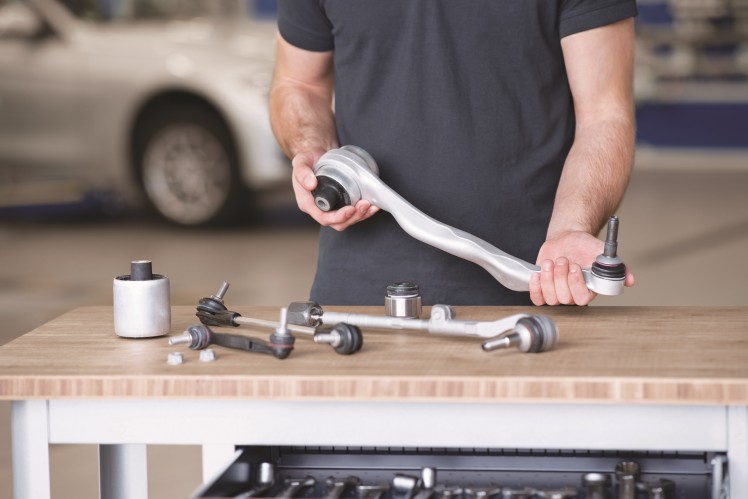ZF Aftermarket extends its Lemförder product portfolio for electric and hybrid vehicles - New rubber-to-metal components for electric and hybrid vehicles in line with market growth & demand
- Lemförder spare parts in high OE quality
- Installation position of the rubber-to-metal components is vital
ZF Aftermarket offers a comprehensive range of OE quality steering and chassis components under its Lemförder brand. When it comes to safety critical systems such as the chassis, it’s imperative that the different components interact perfectly. It therefore pays to fit parts which have been designed, manufactured and tested by the company who devised the technology which sits behind them. With a continuous development program in place across its brand portfolio, the latest offering from ZF Aftermarket’s Lemförder brand is rubber-to-metal components for electric and hybrid vehicles.

Steering and chassis components retain and guide the vehicle wheels; providing the connection between the vehicle and road they are indispensable for safe, comfortable driving. Only absolute precision in the design, manufacture, quality control and assembly of all components ensures that the vehicle is safe on the road at all times.
“With the continued rise in hybrid and electric vehicles, the aftermarket needs to have access to rubber-to-metal components in OE quality to pass on to their customers and secure market growth within the sector.” explains Richard Adgey, Head of Product Management ZF Aftermarket. “With the power of ZF behind its Lemförder brand, these parts provide optimum steering behavior and driving stability as well as preventing noise being transferred into the vehicle.”
In line with the increasing demand for electric and hybrid vehicles, ZF Aftermarket is working hard to expand the Lemförder product portfolio. It includes: suspension-strut mounts, link mounts and engine mounts for the BMW i8; link mounts and suspension-strut mount repair kit (including relevant rolling bearing) for the VW e-Golf and link mounts, suspension-strut mount repair kit and transmission mounts for the Audi A3 e-tron. In the future, ZF Aftermarket will also offer axle beam mountings for the rear axle on the Renault ZOE electric vehicle under its Lemförder brand.
ZF Aftermarket recommends regular checks on all rubber-to-metal components. These are not conventional wear parts, but can reveal signs of serious fatigue as they perform complex tasks in which they are subjected to high dynamic load.
Installing and removing these high-quality components requires the right tools and some simple rules should be followed to avoid costly mistakes
- The installation position must be strictly adhered to. In some cases, the positioning marks are on the actual parts or on the installation location in order to permit the exact mounting of the new bearing. If not, the position should be marked prior to removing the defective bearings.
- Never use oil as an assembly aid. If oil comes into contact with the rubber, it will damage it. Instead, ZF Aftermarket recommends using simple soap suds.
- When dealing with link and suspension-strut mounts, only securely tighten the clamping screws with the required torque once the vehicle is in its assembly position again. This prevents distortions in the bearing that could lead to premature wear of the new parts.
- New rubber-to-metal components for electric and hybrid vehicles in line with market growth & demand
- Lemförder spare parts in high OE quality
- Installation position of the rubber-to-metal components is vital
ZF Aftermarket offers a comprehensive range of OE quality steering and chassis components under its Lemförder brand. When it comes to safety critical systems such as the chassis, it’s imperative that the different components interact perfectly. It therefore pays to fit parts which have been designed, manufactured and tested by the company who devised the technology which sits behind them. With a continuous development program in place across its brand portfolio, the latest offering from ZF Aftermarket’s Lemförder brand is rubber-to-metal components for electric and hybrid vehicles.

Steering and chassis components retain and guide the vehicle wheels; providing the connection between the vehicle and road they are indispensable for safe, comfortable driving. Only absolute precision in the design, manufacture, quality control and assembly of all components ensures that the vehicle is safe on the road at all times.
“With the continued rise in hybrid and electric vehicles, the aftermarket needs to have access to rubber-to-metal components in OE quality to pass on to their customers and secure market growth within the sector.” explains Richard Adgey, Head of Product Management ZF Aftermarket. “With the power of ZF behind its Lemförder brand, these parts provide optimum steering behavior and driving stability as well as preventing noise being transferred into the vehicle.”
In line with the increasing demand for electric and hybrid vehicles, ZF Aftermarket is working hard to expand the Lemförder product portfolio. It includes: suspension-strut mounts, link mounts and engine mounts for the BMW i8; link mounts and suspension-strut mount repair kit (including relevant rolling bearing) for the VW e-Golf and link mounts, suspension-strut mount repair kit and transmission mounts for the Audi A3 e-tron. In the future, ZF Aftermarket will also offer axle beam mountings for the rear axle on the Renault ZOE electric vehicle under its Lemförder brand.
ZF Aftermarket recommends regular checks on all rubber-to-metal components. These are not conventional wear parts, but can reveal signs of serious fatigue as they perform complex tasks in which they are subjected to high dynamic load.
Installing and removing these high-quality components requires the right tools and some simple rules should be followed to avoid costly mistakes
- The installation position must be strictly adhered to. In some cases, the positioning marks are on the actual parts or on the installation location in order to permit the exact mounting of the new bearing. If not, the position should be marked prior to removing the defective bearings.
- Never use oil as an assembly aid. If oil comes into contact with the rubber, it will damage it. Instead, ZF Aftermarket recommends using simple soap suds.
- When dealing with link and suspension-strut mounts, only securely tighten the clamping screws with the required torque once the vehicle is in its assembly position again. This prevents distortions in the bearing that could lead to premature wear of the new parts.
MEDIA
CONTACT

